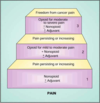Palliative Care: Ageing and End of Life Care Flashcards
What is palliative care?
Approach to improve QoL of patients and their families facing the issues assoc. with life-threatening illness, via prevention and relief of suffering
Inv. pain treatment as well as physical, psychosocial and spiritual issues
What is a good death?
This is culturally / INDIVIDUALLY determined and they must be asked what they would prefer; often includes freedom from pain/distress, peace and being with loved ones
“Granny test” - imagine how you would like your loved one to pass
Key elements involved with care of the dying?
- Recognition that the patient is dying
- Communication with the patient, whenever possible, and with family/loved ones
- Spiritual care (confronting questions about morality and purpose)
- Anticipatory prescribing for pain, respiratory tract secretions, agitation, N&V and dyspnoea
- Clinical interventions must always be in the patient’s best interest (not burdensome)
- Hydration and nutritional review (inc. commencement or cessation)
- Discussing the care plan with patient and relative/carer
- Regular assessment of the patient
- Dignified and respectful care after death
How to recognise that a patient may be dying?
Worsening weakness and performance status; sleeping more and eventual unconsciousness
Worsening physiological status with no reversibility, e.g: chronically hypotensive, tachycardic, etc
Struggling to manage oral drugs
Losing interest in food and fluid
ENSURE THEIR ARE NO REVERSIBLE FACTORS
Explain the WHO analgesic ladder (used for cancer pain Mx)

How to start morphine in the elderly?
Start low and go slow, e.g:
- Oramorph 2.5mg QDS (regular therapy)
- Oramorph 2.5mg prn (breakthrough dose)
What is a breakthrough dose of morphine?
A dose that is given in addition to regular therapy, in order to “breakthrough” pain; it is prescribed and then given as required during that day to gauge whether or not the regular dose is high enough
E.g: if a patient uses many breakthrough dosages, this is an indication that their pain Mx is poor
How is morphine typically prescribed?
Usually twice daily long-acting MST as a background analgesia
+
Oral, immediate release morphine (oramorph) as a “breakthrough” dose; this is typically 1/6th of the total daily dose This is reviewed daily
What medications are typically prescribed alongside morphine, to negate the side effects?
Laxative, as morphine causes constipation
Anti-emetic (parenteral), as morphine causes N&V, e.g: metoclopramide is a good choice as it is a pro-kinetic drug and morphine reduces the rate of stomach emptying, however it is contraindicated in Parkinson’s disease
Example of changing morphine dose?
Previous 24 hours, a patient has:
- 6 breakthrough doses of 2.5mg = 15mg
- Regular oramorphh of 10mg
Total dose is 25mg in 24 hours
So, start MST 10mg BD
Examples of calculating breakthrough doses?
Patient taking MST 5mg BD:
• Breakthrough dose is 2mg oramorph (~10mg/6)
Patient taking MST 50mg BD:
• Breakthrough dose is 15mg oramorph (100mg/6)
Routes for delivery of medication in symptom control?
Oral route is used but is often not possible
Smoothest delivery of drugs is via continuous subcutaneous infusion using a SYRINGE DRIVER (up to 3 medications can be mixed in here, inc. opioids, anti-emetics, etc; it is infused over 24 hours and changed daily
Advantageous in that it may be used in hospital and community
How to convert dosage of morphine from PO to SC?
Morphine is 2x as potent when given SC; divide the PO dose by 2, e.g:
• Oral MST 10mg BD = SC morphine 10mg over 24 hours
Medications commonly used in anticipatory prescribing a the end of life?
Pain/SoB - morphine
Distress - midazolam
N&V/agitation - levomepromazine
Respiratory secretions - buscopan

